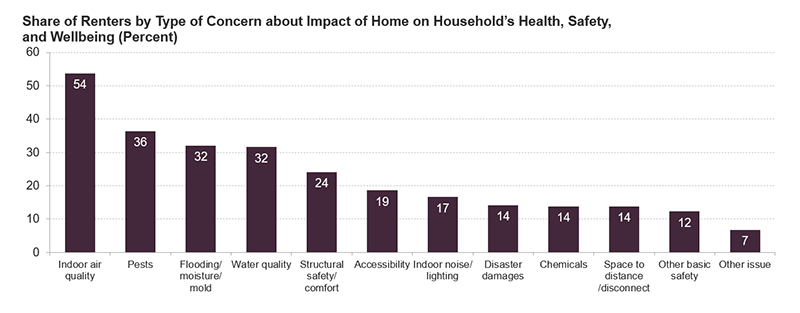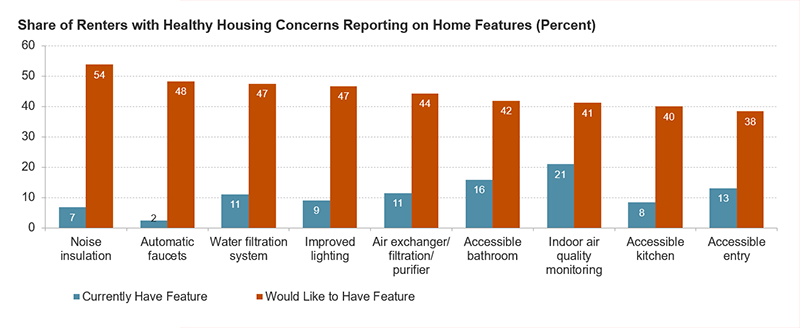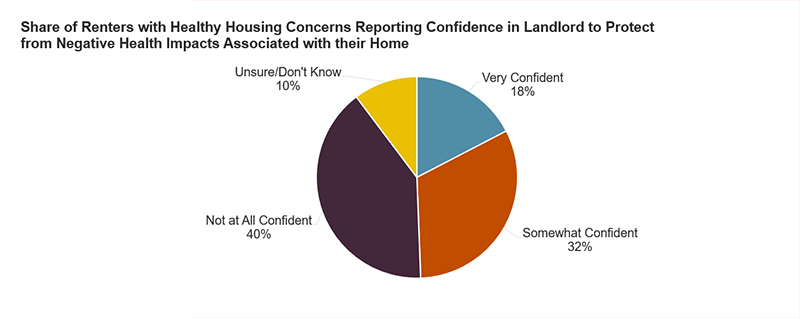New Survey Finds Many Renters Are Concerned about the Impact of Home on Health
Fully 43 percent of renter households worry about their home negatively affecting their or another occupant’s health, safety, and wellbeing according to a survey conducted last September by the Center’s Remodeling Futures program in partnership with The Farnsworth Group. The 2021 Harvard JCHS-Farnsworth Group healthy homes survey also found that COVID-19 exposure risks and having symptoms of illness (such as difficulty breathing, headaches, rashes, etc.) or a diagnosed condition were the most common reasons for respondents’ concerns. Yet, many rental units lack healthy housing features that could alleviate tenant concerns, and many renters do not trust their landlords to appropriately address healthy housing issues. With people spending considerably more time in their homes since the onset of the pandemic, the need for safe and healthy housing has become even more urgent. Certainly, the pandemic magnified public awareness of indoor air filtration and ventilation, but a healthy home also encompasses issues of water quality, pests, mold and moisture, chemical hazards, noise and lighting, basic safety, structural deficiency, accessibility, disaster mitigation, and more.
According to the survey, renters who expressed healthy housing concerns tended to be older and had lower incomes compared with the broader renter population in the US. The most common reasons for renters’ concerns about the impact of home on health, safety, and wellbeing were risks of COVID exposure (cited by 42 percent of respondents) and having a household member with health symptoms or a diagnosed condition (40 percent), or mobility limitations (20 percent). Indeed, most renter households with concerns included persons with serious health conditions or difficulties. More than two-thirds of respondents reported having someone in the household with severe allergies (32 percent), asthma (27 percent), or a physical or cognitive impairment such as serious difficulties walking or climbing stairs (22 percent); concentrating, remembering, or making decisions (17 percent); or doing errands alone (14 percent).
Among renters with concerns about their homes’ negative impact on health, indoor air quality was by far the greatest area of concern (Figure 1). Over half of respondents reported indoor air quality as a source of concern, which was also the greatest area of concern for renters in a similar healthy homes survey from 2018. This finding may not be surprising given the large share of respondents worried about being exposed to COVID, the relatively high shares of concerned renter households that include persons with severe allergies or asthma, and the fact that people with pre-existing medical conditions such as moderate or severe asthma are more likely to be hospitalized from COVID-19. Specific concerns for indoor air quality encompassed contamination by bacteria or viruses; dust and dander; pollutants, odors, or smoke; lack of ventilation; and excessively low humidity. Many renters also expressed concerns about pests (36 percent); flooding, moisture, or mold (32 percent); water quality (32 percent); structural safety and comfort of the home (24 percent); and accessibility (19 percent).
Figure 1: Air Quality, Pests, and Water Damage Top List of Renter Concerns About the Impact of Home on Health
Notes: Out of a sample of 253 renters concerned about healthy housing issues in the past year. Question asked: “Which categories best describe your concern about the impact of your home on your household’s health, safety, and wellbeing?” Multiple selections accepted.
Source: JCHS tabulations of Harvard JCHS-The Farnsworth Group Healthy Homes Surveys, September 2021.
There are a variety of home features, systems, and technologies that can mitigate or remediate hazards and make homes safer and healthier for occupants. Examples of healthy housing features might include relatively simple and inexpensive components like a kitchen range hood or bathroom exhaust fan. More complex and expensive healthy home features might include a water filtration system or advanced whole-house insulation. Very few renters with healthy housing concerns reported having healthy home features in their home, even though large shares of renters would like to have such features (Figure 2). Only about one in five renter respondents said their home already had indoor air quality monitoring and one in ten reported having a whole-house air exchange, filtration, or purification system. A similarly low share (11 percent) reported having a water filtration system in place. Yet, large shares of renters said they would like to have these and many other healthy home features. Over half of renters with healthy housing concerns said they would like noise insulation in their unit and about half wanted automatic faucets, a water filtration system, or improved lighting. Significant gaps also exist between concerned renters who have accessible home entries, kitchens, or bathrooms and those who would like—or more likely need—to have such features.
Figure 2: Few Renters Have Home Features That Many Would Like to Address Health, Safety and Wellbeing Concerns
Notes: Out of a sample of 253 renters concerned about healthy housing issues in the past year. Question asked of 60 features: “To the best of your knowledge, which of the following health and safety features does your rental home have, and which would you like to have but currently do not?”
Source: JCHS tabulations of Harvard JCHS-The Farnsworth Group Healthy Homes Surveys, September 2021.
Renter respondents expressed strong interest in having health and safety features in their home, yet renters typically have little control over their home’s features. A renter’s ability to address their healthy housing concerns with home modifications or hazard mitigation ultimately resides with their landlords or property owners and their landlords’ capacity to invest in retrofits and other improvements. Only 18 percent of renters with healthy housing concerns were very confident that their landlord or property manager would take any action necessary to protect their household from negative health impacts or risks associated with their rental unit, and fully 40 percent of concerned renters reported having no confidence in their landlords to remedy their healthy housing issues (Figure 3). Certainly, some healthy home features such as automatic faucets or improved lighting may be considered discretionary modifications that tenants could make at their own expense with permission from the property owner. However, other features related to basic safety and accessibility may be legally required of landlords by building codes and fair housing laws. Of course, compliance with and enforcement of these codes and laws still often relies on renters advocating for their need for modifications, repairs, or remediation to their homes.
Figure 3: Two in Five Renters Do Not Believe Landlords Would Address Negative Health Impacts of Their Home
Notes: Out of a sample of 253 renters concerned about healthy housing issues in the past year. Question asked: “How confident are you that your landlord/management company would take any action necessary to protect your household from negative health impacts and/or risks potentially associated with this rental unit?”
Source: JCHS tabulations of JCHS-Farnsworth Healthy Homes Surveys, September 2021.
Meanwhile, large shares of renter respondents with healthy housing concerns reported activities (or nonactivities) by their landlord or property manager that negatively affected their health, safety, and wellbeing. Twelve percent of renter respondents said they or a household member had been frequently disturbed or harmed by maintenance or other activities by their landlord or property manager that compromised indoor air quality or enjoyment of their rental unit, and another 29 percent reported occasional disturbance or harm of this nature. While some of these complaints involved construction noise and air pollutants, many more were for landlord negligence in upkeep and repairs including for critical safety concerns such as rotting steps, faulty electrical wiring, extensive water damage, or mold. Of these renters experiencing occasional or frequent disturbances by their landlord (105 respondents), 21 percent said their landlord “eventually addressed their concerns, with some reluctance,” while 34 percent said their landlord refused or otherwise failed to satisfactorily address their concern. Another 17 percent did not even bring their issues to the attention of their landlord. Reluctance of renters to bring substandard housing issues and complaints to landlords may result from fear of eviction, rent increases, or other types of retaliation, as well as fear of COVID exposure.
Rental homes that are structurally safe and well-maintained, well-ventilated, free of pests and contaminants, and accessible for those with disabilities are essential for the health, safety, and wellbeing of their occupants. Yet, with many property owners reducing operating expenses and deferring maintenance during the pandemic, the rental housing stock is in danger of falling further into disrepair. If landlords also reduce investments in critical capital improvements such as roof replacements or HVAC upgrades, concerns will only grow for the negative health impacts of households living in inadequate rental homes. Worsening housing conditions would disproportionately impact the health and safety of the nation’s most vulnerable renters including those who are older, have lower incomes, and those with serious health conditions or disabilities.
When renters’ concerns for healthy housing go unaddressed by landlords and property managers for any reason, renters face difficult choices to either remain in unhealthy and inadequate homes or try to find better housing. Among renters with healthy housing concerns, fully 37 percent reported that in recent years their concern caused them or another household member to move or seriously consider moving to another rental unit. Yet, in many cases a renter’s need for hazard remediation or healthy home features may take a back seat to more pressing needs such as maintaining housing affordability or stability. Given widespread income losses, dramatically rising rents, and tightening vacancies across the country since the pandemic, many renter households with concerns for their health would surely struggle to find and afford better, healthier housing. Public efforts to invest in or incentivize the preservation and expansion of the existing affordable rental housing stock must ensure the basic physical adequacy, health, and safety of these rental units as much as the housing cost burden.




